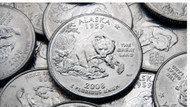Rare State Quarters and Others Worth Money
Posted by Andrew Adamo on Mar 11th 2024
Rare State Quarters Worth Money
From 1999 through 2008, the United States Mint issued a series of quarter dollar coins known as the state or statehood quarter program. It was followed in 2009 by quarters for the five U.S. territories and the District of Columbia. Even though most state quarters worth 25 cents, some rare state quarters worth money.
Quarters were released each year for five different U.S. states in the order in which they were admitted to the union starting with Delaware. They featured a slightly modified portrait of our first president, George Washington, on their obverses and unique reverse designs that celebrated historical, sentimental or geographic aspects of that state. About 400 million quarters were issued for each state, or about 35 billion coins altogether!
This program was very successful for the Mint and the numismatic hobby. Billions of dollars in seigniorage, or the difference between the cost to produce a coin and its face value, were generated. And millions of Americans were introduced through these coins to the exciting world of coin collecting. It has been estimated that the state quarters were collected to one degree or another by about half of the U.S. population!
Rare state quarters
Most of the state quarters you come across in your change are only worth their face value or slightly more even in uncirculated condition. But some of them are worth much more, rare state quarters worth money can reach $10,000 or more!
In general, state quarters with the lowest mintages typically are worth more than ones with higher mintages. But since all state quarters have mintages that are in the hundreds of millions, most are not rare unless they have something special.
Rare and valuable state quarters worth money are usually either very high-grade examples, or error coins that were struck with certain characteristics that are not found on regular examples. That includes, for example, doubling of the die or die cracks. And some of them lack certain elements such as edge inscriptions.
In addition, the coins issued during the first year, 1999, are more valuable. That is partly due to lower supply since those coins were likely saved when they came out and high demand too as first year of issue coins.
Top 10 state quarters worth money
While there are no low-mintage key dates in this series, the 1999 Delaware quarter is MS69 – of which PCGS has only graded one – is presently valued the highest at $14,000. But there are no recent sales of this coin above the MS68 level.
1999 Delaware experimental quarter
When the U.S. Mint was working to develop planchets for the Sacagawea dollar that had a manganese alloy in them and that was done using state quarter dies because they were similar in diameter to the dollar coins.
For each of the first year 1999 state quarters a small number of examples were struck at the Philadelphia Mint in a manganese alloy. Some numismatists consider these coins patterns, while others view them as error pieces. A total of 20 such coins have been discovered and their origin verified by the U.S. Mint.
A PCGS MS66 example of the 1999-P Delaware coin sold in 2019 for $3,840.

2003-D Maine Quarter
Maine quarters are among those that are harder to find, especially in very high grades, because of its lower mintage. Any example that graded MS67 or higher is valuable. An MS68 sold in 2017 for $2,300.
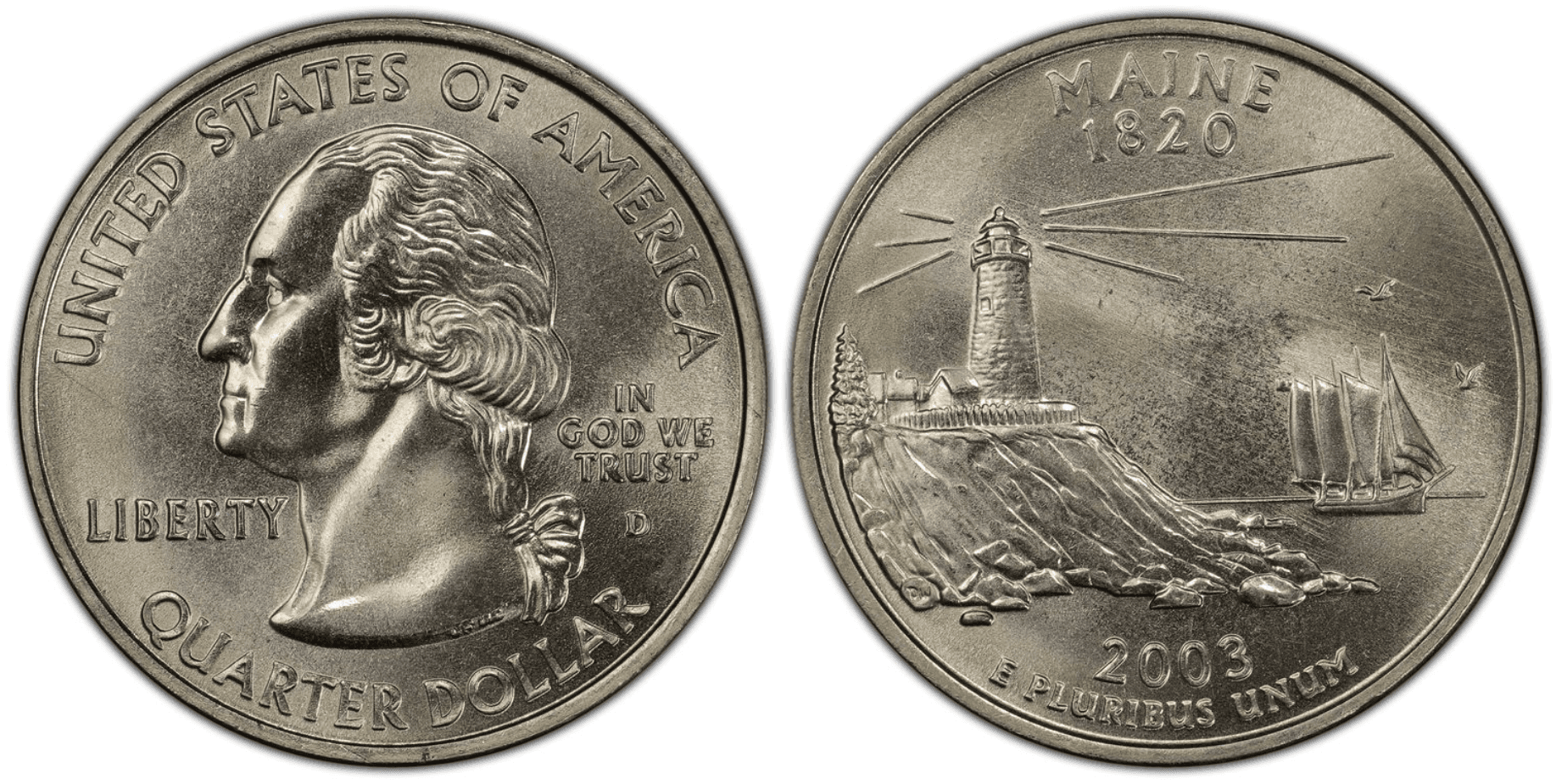
2000-P South Carolina Quarter
In MS67 and lower grades, this quarter is not very rare or valuable. But in MS68 or higher it is rare. An MS69 sold in 2017 for $3,525. PCGS has only graded one coin at this level.
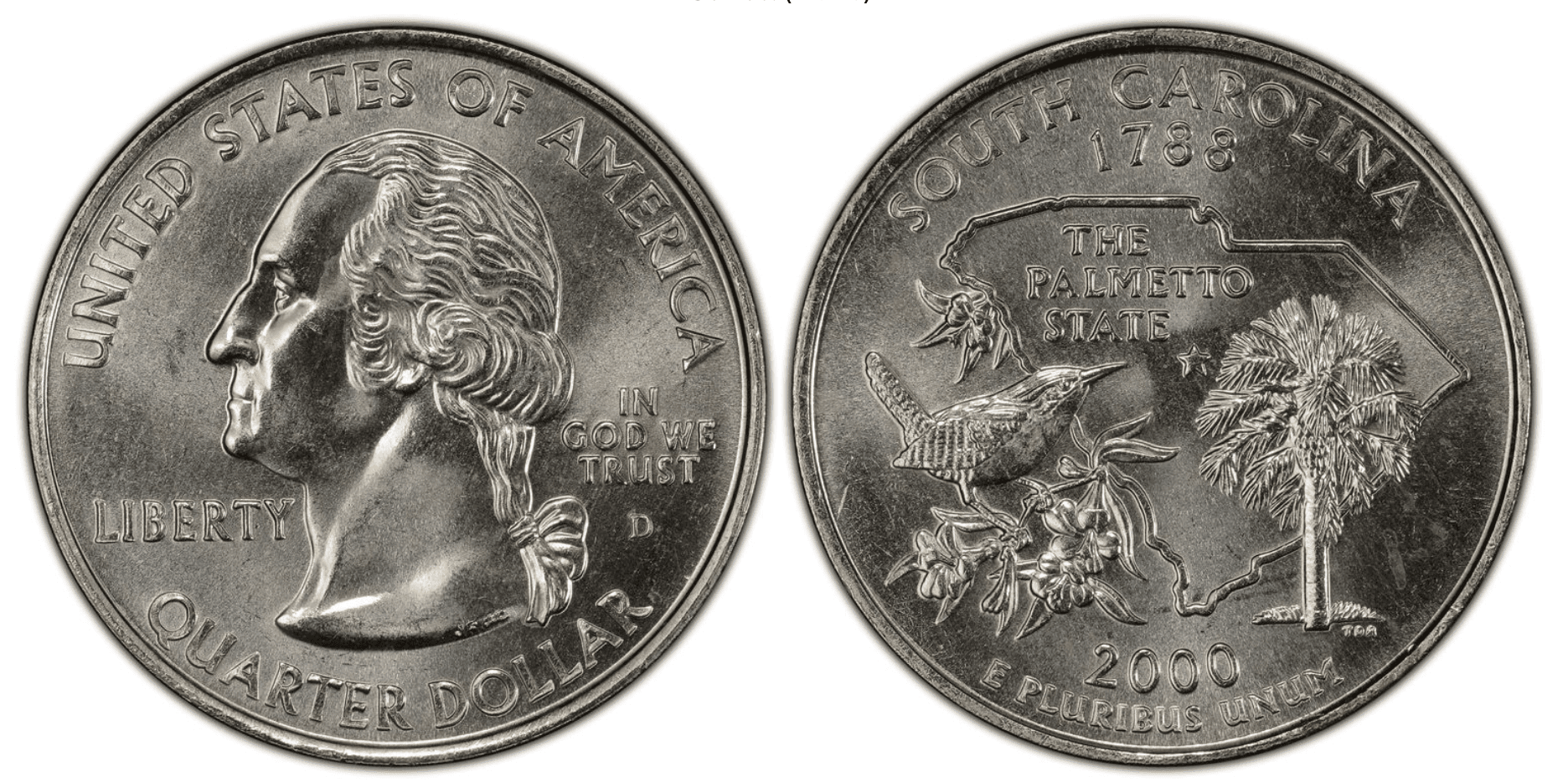
2004-D Wisconsin Extra Leaf Error High
In 2004 collectors began discovering that some Wisconsin quarters had extra leaves in the corn husks in the design. Some are high leaf and others are low leaf. High leaf coins are much more scarce than low leaf coins. These coins are the most significant error discovered among state quarters.
An example of the high leaf graded MS67 sold in 2020 for an impressive $6,000. A lower-grade mint state example might be worth about $100.
The other variety, the low leaf coins, are worth less than the high leaf ones since they are scarcer.

1999 Connecticut Experimental Quarter
Another one of those quarters from 1999 struck on experimental planchets was issued for Connecticut. An MS69 example sold for $10,500 in 2018. PCGS designates these coins as mint errors.
An important aspect of these experimental planchets coins is that there are four distinct types based on the color of the quarter.
Some have the color of a Sacagawea dollar and have a copper center core. The second type has the same color as those dollar coins but lacks the copper core. The third type has a slight green color and has a copper center core. The final type has a slightly green color but does not have the copper center core.
These error coins are also thicker and heavier than regular state quarters.
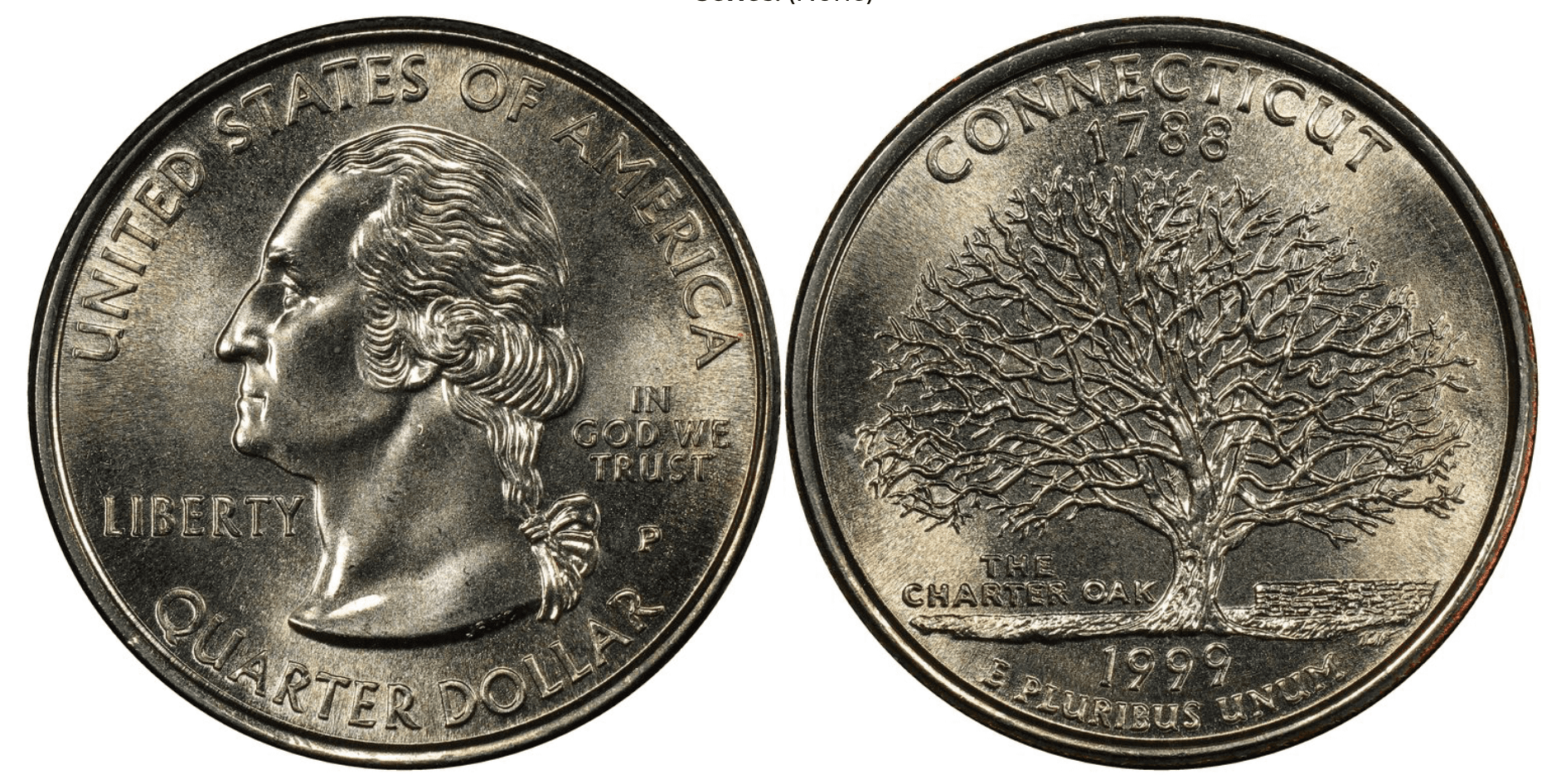
1999-P Delaware Quarter
1999 Delaware quarters are some of the harder ones to find especially in high grades because as the first coin issued during the first year of the state quarter program, these coins were widely hoarded because collectors know first issues tend to be valuable.
A PCGS MS66 example of this popular issue sold in 2018 for $4,888.
1999 Pennsylvania Experimental Quarter
Another one of those experimental coins struck in 1999 to test the alloys for the Sacagawea dollar was issued for Pennsylvania and an example that graded PCGS MS67 sold for $10,200 in 2018.

2006-D North Dakota Quarter
A very high-grade example of this coin, a PCGS MS68, sold in 2017 for $3,760. The coin is scarce in -grades of MS67 and higher, and PCGS has to date only graded two of these coins at the MS68 level.

2004-P Texas Quarter
This is another state quarter that is very scarce at the MS68 level or higher. An example graded as NGC MS69 for this issue sold for $3,055 in 2017.
At the MS68 level for this issue 109 coins have received that grade at PCGS, but at the MS69 level, it has graded just one coin. The PCGS price guide currently values this top pop coin at $10,000.
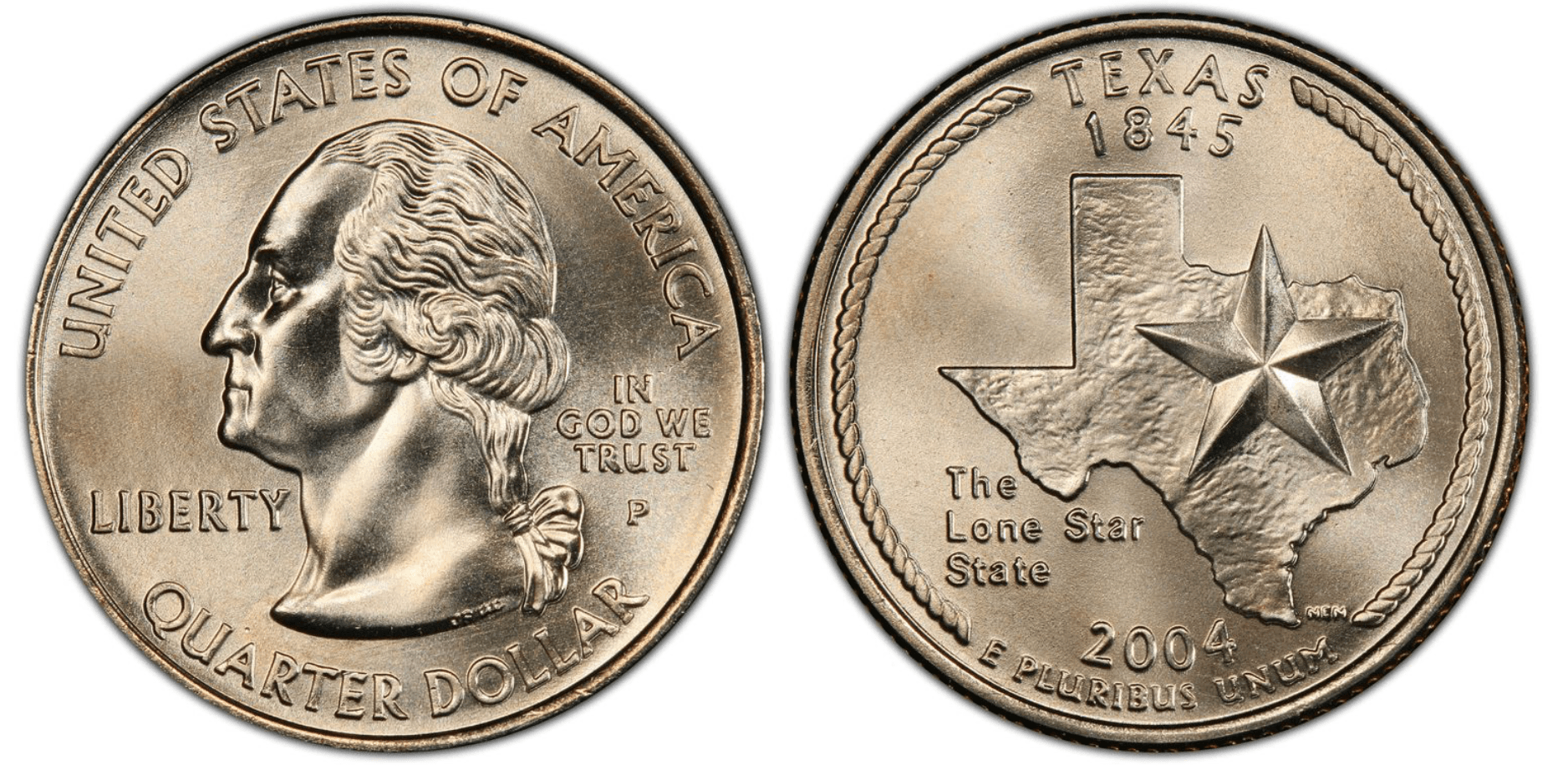
1999-D Connecticut Quarter
26 examples of this issue have been given the grade of PCGS MS68 (the highest found to date) and they are currently valued at $1,000.
But in 2018 an example of the coin at the same grade sold for $2,300. The reason the coin is currently worth less is that more of these coins have been graded in the years since that coin was sold.
State quarter errors
In addition to the coins that are among the rarest of the series and those that have sold for the highest prices, there are also plenty of other state quarters that are worth money and worth looking for.
These include the 2008-D New Mexico quarter missing edge letter, Normally, a quarter like this one would not be very valuable below the MS67 level. But an example graded MS62 sold in 2021 for $2,500 that was missing the edge lettering that is supposed to be on the coin.
There are other error state quarters. In fact, coins from each state have been found with various types of errors.
There are 1999 Delaware quarters with die cracks that resulted in extra metal around the horse’s mouth, which are known as spitting horse errors. These are worth from $5 to $15 circulated and about $30 in mint state.
There are 2005 Minnesota quarters with doubled dies in which their value depends on how dramatic the doubling is.
There are strike-through errors caused by grease that builds up. Some are more common and less valuable like 2005 Kansas quarters known as “In God We Rust” because the extra metal in the die from grease resulted in coins with the “T” not striking properly.
State Quarters Worth Money FAQ
- What makes a state quarter rare and valuable?
- A state quarter can become rare and valuable due to minting errors (like double strikes, off-center errors, or die cracks), limited mintages, or special conditions such as being part of a proof set. Quarters with significant errors or those in exceptionally high grade are especially sought after by collectors.
- Which state quarters are considered the rarest and most valuable?
- Notable rare state quarters include the 2004-D Wisconsin Extra Leaf High and Low quarters, the 2005 Minnesota quarter with extra tree errors, and some 1999 Delaware Spitting Horse errors. Their values vary significantly depending on the error and the coin's condition.
- How much is a 2004-D Wisconsin Extra Leaf quarter worth?
- The 2004-D Wisconsin Extra Leaf quarters can be worth from a few hundred to over a thousand dollars, depending on the variant (High or Low) and the coin's condition. These are among the most well-known error coins from the state quarters series.
- Are there any valuable errors found in the 50 State Quarters proof sets?
- While proof sets are generally high-quality and errors are rare, any errors found in proof sets, such as misprints or misstrikes, can enhance the set's value. However, these errors are extremely rare and not widely reported, making them highly collectible.
- Can a regular state quarter without errors be worth more than face value?
- Regular state quarters in circulation are typically worth only their face value of 25 cents. However, uncirculated coins or those in mint condition, especially if they are part of a complete set, can fetch a premium among collectors. Silver proof quarters made of 90% silver are also more valuable than their clad counterparts.
- What should I look for in state quarters to determine if they're valuable?
- Look for errors such as misprints, off-center strikes, double strikes, or unusual markings. Additionally, check for quarters from proof sets or those made with silver content, as these can be more valuable than standard circulated coins.
- Where can I sell my rare state quarters?
- Rare state quarters can be sold at coin shops, coin shows, online through auction sites like eBay, or through specialized numismatic auction houses. Ensure you have your coins authenticated and graded by a reputable service for the best results.
- How do I know if my state quarter is a rare error coin?
- Familiarize yourself with known error types and compare your coin to verified examples. Consider having your coin evaluated by a professional grading service like PCGS or NGC for an expert opinion on whether it's a genuine error coin.
- Are colorized or gold-plated state quarters worth anything?
- Colorized or gold-plated state quarters were aftermarket modifications not sanctioned by the U.S. Mint. While they may hold appeal for some collectors, they generally do not carry significant numismatic value over their face value, except for a small premium due to their novelty.
- What impact does the coin's condition have on its value?
- The condition of a coin significantly impacts its value, with higher grades (uncirculated or proof condition) fetching higher prices. Error coins in better condition are particularly valuable, as the details of the error are more pronounced and preserved.
- What quarters are worth money?
Pre-1965 Silver Quarters: Quarters minted in 1964 and earlier were made of 90% silver, making them worth more than their face value due to the silver content. The exact value depends on the current price of silver.
State Quarter Errors: Some state quarters have errors that make them more valuable. Notable examples include:
2004-D Wisconsin Extra Leaf High and Low Quarters: These errors feature an additional leaf on the corn stalk depicted on the quarter. They can fetch hundreds to thousands of dollars depending on the condition.
2005 Minnesota Double Die Quarter: Features doubling of the tree designs. The value varies based on the severity of the doubling and the coin's condition.
1999 Delaware Spitting Horse Error: This error features a die crack on the coin that makes it appear as if the horse is spitting. Value varies based on visibility and condition.
2009 District of Columbia Doubled Die Quarters: These quarters have doubling on Duke Ellington’s elbow, making them more valuable to collectors.
Rare Dates and Mint Marks: Certain dates and mint marks are known for their low mintage, making them more valuable. Examples include:
1932-D and 1932-S Washington Quarters: These quarters have low mintages and are among the most sought-after by collectors.
1937-S, 1938-S, 1940-D, 1942-S, and 1950-D/S Over mintmark: These quarters are rare and have specific minting anomalies that increase their value.
Standing Liberty Quarters (1916-1930): Early years, especially the 1916 Standing Liberty quarter, are highly valued due to their low mintage and historical significance. The 1916 quarter is one of the rarest and most valuable in the series.
Proof and Special Mint Set (SMS) Quarters: Proof and SMS quarters, particularly those with low mintage numbers or errors, can be worth more than regular issues. Proof sets in silver from 1992 onwards also carry a premium.
Territorial Quarters with Errors: Like the state quarters, territorial quarters (issued in 2009) with errors or anomalies can also be valuable.
Special Edition and Commemorative Quarters: Certain special edition quarters, such as the 2019-W mint mark quarters released into general circulation, are sought after due to their limited distribution.
Colorized or Gold-Plated Quarters: While not produced by the U.S. Mint, quarters that have been colorized or gold-plated by third parties may hold some novelty value, though generally, they're not highly valued in numismatic circles unless they have other rare characteristics.

